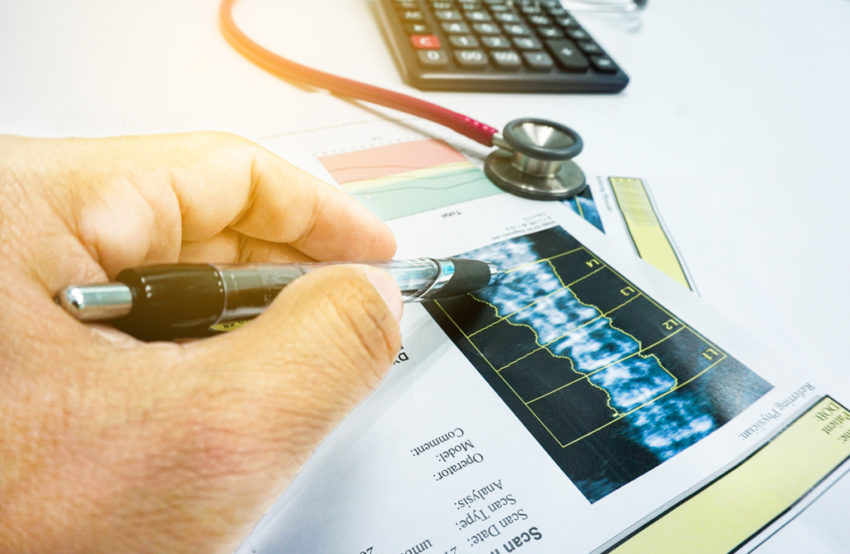Doctors often refer potential osteoporosis patients for DEXA scans to measure bone density. However, some folks may not have a facility with one nearby, or don’t want or can’t have radiation exposure. Regardless, there are DEXA scan alternatives for bone density. In the article below I will address the three most common alternatives to a DEXA scan.
3 DEXA Scan Alternatives for Bone Density
There are 3 popular alternative methods used to measure bone density besides a DEXA scan. These are ultrasound, Quantitative computed Tomography (QCT), and Peripheral Quantitative Computed Tomography (pQCT). Below I will discuss what each is, how they compare to DEXA for bone density, the radiation exposure, and the cost.
Ultrasound for Measuring Bone Density
Ultrasound is a sound wave that’s used to create an image. Usually, it involves placing a small sensor against the skin to emit sound waves into the body. The waves then bounce off bones and other tissues and are converted into an image on a monitor. This image can be used to estimate bone density and strength.
Ultrasound is noninvasive, painless, and doesn’t use ionizing radiation. This makes it a good choice for people who are pregnant or may be at risk for radiation exposure. Ultrasound is also widely available and relatively inexpensive ($200 to $400)
The main downside of ultrasound is that it’s not as accurate as DEXA. In addition, ultrasound is operator-dependent, which means that the results can vary depending on who is performing the test.
Ultrasound is a good choice for people who are pregnant or may be at risk for radiation exposure.
Quantitative Computed Tomography (QCT) for Measuring Bone Density
Quantitative Computed Tomography (QCT) is a type of X-ray that’s used to measure bone density. QCT is similar to DEXA in that it uses low doses of ionizing radiation. However, QCT produces 3D images of the bones, which is slightly less accurate than DEXA.
QCT is also operator-dependent, which means that the results can vary depending on who is performing the test. In addition, QCT is more expensive than DEXA ($500 to $1,000), and it’s not widely available.
QCT is a good choice for people who want a DEXA scan alternative for measuring bone density, but it’s more expensive, has more radiation exposure, is less accurate, and is not widely available.
Radiation Exposure of QCT
QCT uses low doses of ionizing radiation, similar to DEXA. However, the effective dose of radiation from a QCT scan is about 100 to 300 mrem, which is more than a DEXA scan.
Peripheral Quantitative Computed Tomography (pQCT) for Measuring Bone Density
Peripheral Quantitative Computed Tomography (pQCT) is a type of X-ray that’s used to measure bone density in the extremities, such as the forearm, hand, or foot. pQCT is similar to DEXA in that it uses low doses of ionizing radiation.
pQCT is less operator-dependent than other methods, which means that the results are more consistent. In addition, pQCT is more expensive than DEXA ($300 to $500).
pQCT Devices can measure cross sections of both cortical and trabecular bone, which then enables researchers to analyze the different constituents of bone mass separately. Additionally, this process provides advantages over DXA in terms of possible genotype/bone phenotype correlations. pQCT is a good choice for people who want a more accurate test than DEXA, but it’s more expensive.
Radiation Exposure
pQCT uses low doses of ionizing radiation, similar to DEXA. The effective dose of radiation from a pQCT scan is about 0.01 mSv, which is a bit higher than DEXA which is between 0.004–0.005 mSv.
DEXA Scan Alternatives for Bone Density without Radiation?
If you want an alternative to DEXA that doesn’t use radiation, ultrasound is the best choice. Ultrasound is noninvasive, painless, has no radiation, and is relatively inexpensive. The main downside of ultrasound is that it’s not as accurate as DEXA.
The Most Accurate DEXA Scan Alternatives for Bone Density Scanning
If you want a more accurate test than DEXA, but you’re willing to pay more, pQCT is the best alternative for measuring bone density.
3 DEXA Scan Alternatives for Bone Density- The Bottom Line
DEXA scans are the gold standard for measuring bone density and they are easy to locate facilities. However, there are alternatives available for those who can’t or don’t want to have a DEXA scan. Ultrasound, QCT, and pQCT are all viable alternatives, but they have their pros and cons. Talk to your doctor to see if one of these methods is right for you.
